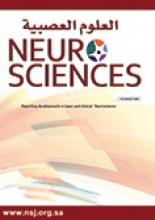Article Figures & Data
Tables
Variables Monotherapy
39 (57.3)Polytherapy
21 (30.9)Without medication
8 (11.8)P-value n (%) Average age ±SD (min-max) 28.79±5.8 31.2±6.3 23.6±2.1 0.12 (17–32) (18–35) (21–26) Age of seizure onset 17.8±9.1 15.7±6.1 14.1±8.1 0.6 (1–35) (3–32) (2–29) Disease duration (years) 12.6±8.9 7.3±5.6 9.2±9.1 0.7 (1–35) (3–32) (2–29) Duration of use of AED (years) 11.7±9.07 12.3±7.3 1.8±2.02 0.1 (0.17–31) (0.08–24) (0–4) Seizure semiology, n (%) Focal seizure 16 (41.0) 11 (52.4) 3 (37.5) 0.36 Generalized seizure 23 (59.0) 10 (47.6) 5 (62.5) Number of pregnancies, n (%) Nulliparous 27 (69.2) 14 (66.7) 6 (75.0) 0.34 Multiparous 12 (30.8) 7 (33.3) 2 (25.0) Electroencephalogram, n (%) Normal 15 (38.5) 5 (23.8) 5 (62.5) 0.6 Abnormal 24 (61.5) 16 (76.2) 3 (37.5) Cerebral imaging (MRI), n (%) Abnormal 7 (17.9) 6 (28.6) 0 (0) 0.5 - Table 2
Association between the frequency of seizures during pregnancy with neonatal birth weight, head circumference and height.
Parameters Seizure frequency in pregnancy: unchanged / decreased / increased P-value Unchanged Decreased Increased Mean±SDMedian (Min-Max) Birth weight (g) 3064±6233105 (1360–4210) 3324±6673410 (1200–4150) 3122±6753110 (1910–3620) 0.812 Head circumference (cm) 33.127±2.46934 (28–37) 34.965±1.99034 (30–38) 32.767±2.36933 (29–37) 0.832 Height (cm) 48.47±3.44150 (40–53) 49.08±3.77749 (41–51) 47.75±3.30649 (40–52) 0.626 Sr # Seizure Semiology Medication used Frequency of seizures during pregnancy Malformation Category Malformation Name Patient 1 Generalized seizure CBZ 900 mg/day Increased Intrauterine death Severe intrauterine growth restriction leading to intrauterine fetal death Patient 2 Focal seizure CBZ 1000 mg/dayLMT 200 mg/day Decreased Facial malformation Cleft lip and cleft palate Patient 3 Generalized seizure VPA 500 mg/dayLMT 50 mg/day Unchanged Intrauterine death Fetal anencephaly leading to still birth Patient 4 Focal seizure CBZ 400 mg/day Unchanged Organ malformation Tetralogy of Fallot Patient 5 Generalized seizure VPA 1250 mg/dayLMT 800 mg/day Unchanged Organ malformation Atrial septal defect Patient 6 Generalized seizure No drug use Unchanged Facial + Organ malformation Fetal gastroschisis along with cleft palate CBZ - carbamazepine, VPA - valproic acid, LMT - lamotrigine






